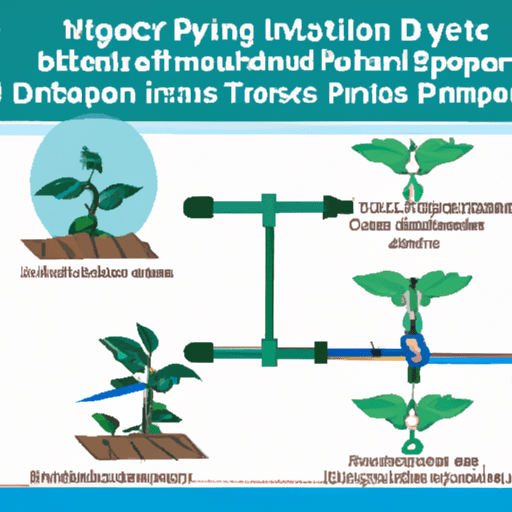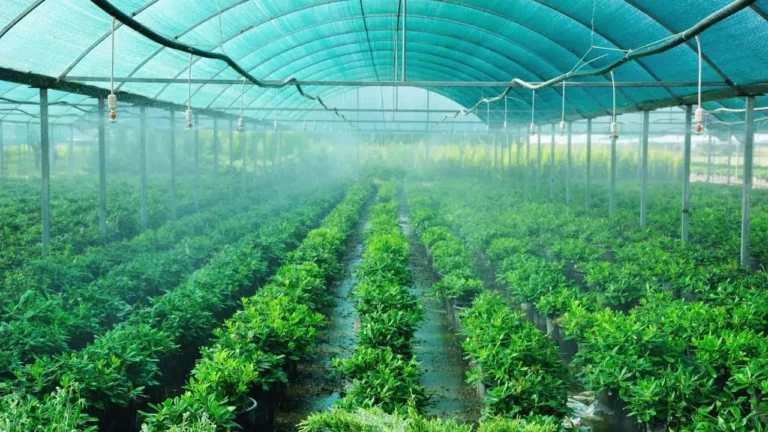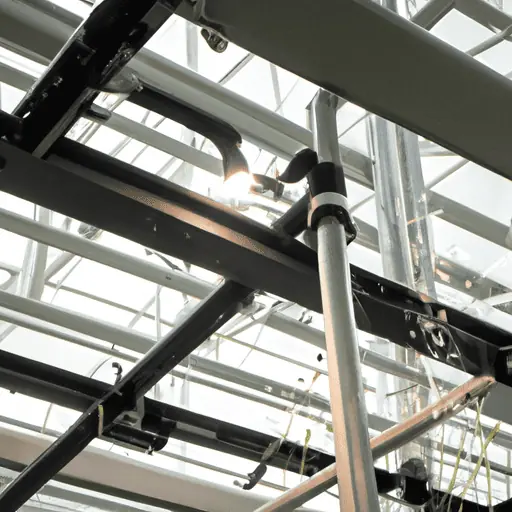This is an introductory guide to the basics of drip irrigation systems, discussing its definition, operation, and the numerous benefits it brings to growers. It provides a comparative analysis of drip irrigation versus traditional irrigation methods, shedding light on why it is a more feasible and sustainable option.
1. What is Drip Irrigation?
Drip irrigation is a method of providing water directly to the roots of plants, using a network of tubes and emitters. Unlike traditional irrigation systems that spray water over a large area, drip irrigation delivers water slowly and directly to the base of each plant. This targeted approach ensures that water is efficiently used and minimizes wastage. Drip irrigation systems can be used in various settings, including gardens, farms, and landscapes.
Drip irrigation systems consist of three main components: a water source, a network of tubes, and emitters. The water source can be a tap, well, or reservoir, and is connected to the network of tubes. These tubes are laid out strategically along the planting area, with emitters spaced at regular intervals. The emitters control the flow of water, allowing it to drip slowly onto the soil near the plant’s roots.
One of the key advantages of drip irrigation is its efficiency. By delivering water directly to the roots, plants can absorb the moisture more effectively, reducing evaporation and runoff. This targeted approach also helps to prevent weed growth, as water is not wasted on unwanted areas. Additionally, drip irrigation systems can be automated, allowing growers to easily control the frequency and duration of watering.
1. An illustration showing the layout of a typical drip irrigation system.
2. “Water is the driving force of all nature.” – How Does a Drip Irrigation System Work?
Drip irrigation systems work on the principle of delivering water directly to the roots of plants, mimicking the natural process of rainwater absorption. The system begins with a water source, which can be connected to a main supply line. This line is then divided into smaller distribution lines that run along the planting area. Along these distribution lines, small openings called emitters are placed at regular intervals. These emitters release water in controlled drips, ensuring a slow and steady flow of moisture to the plants.
The water moves through the distribution lines and reaches the emitters under low pressure. This low-pressure system prevents water from being wasted through excessive runoff or evaporation. The emitters can be adjusted to release different amounts of water, depending on the needs of specific plants or soil conditions. This level of customization allows growers to optimize water usage and ensure that each plant receives the right amount of moisture.
Drip irrigation systems can also be equipped with additional components to enhance their functionality. For example, filters can be installed to prevent clogging of the emitters by removing debris and sediment from the water. Pressure regulators can be used to ensure a consistent flow of water throughout the system. And timers or sensors can be added to automate the watering process, ensuring plants receive water at the most optimal times.
3. The Unquestionable Benefits of Drip Irrigation
Drip irrigation offers a multitude of benefits that make it an attractive choice for growers of all scales. Firstly, it is incredibly efficient in water usage. Unlike traditional irrigation methods that can lead to significant water loss through evaporation or runoff, drip irrigation delivers water directly to the roots of plants. This targeted approach ensures that water is used only where it is needed, resulting in minimal waste.
Additionally, drip irrigation systems promote healthier plant growth. By delivering water directly to the root zone, plants can absorb moisture more effectively, leading to stronger root development and overall better plant health. This, in turn, can result in increased yields and improved crop quality.
Furthermore, drip irrigation can be a time-saving solution for growers. Once the system is set up and properly adjusted, it can be automated through the use of timers or sensors. This means that growers can save valuable time and effort by not having to manually water their plants. They can focus their attention on other important tasks, such as crop management or harvesting.
Drip irrigation is also environmentally friendly. Its precise water delivery system allows for water conservation, reducing the overall amount of water needed for irrigation. This is particularly important in regions where water scarcity is a concern. Additionally, drip irrigation minimizes soil erosion and nutrient leaching, as water is applied slowly and evenly to the root zone, preventing excessive runoff.
3. An infographic highlighting the benefits of drip irrigation for growers.
4. Drip Irrigation vs. Traditional Irrigation Methods: Which is More Efficient?
When comparing drip irrigation to traditional irrigation methods, efficiency is a crucial factor to consider. Traditional irrigation methods, such as sprinkler systems or flood irrigation, often result in significant water loss due to evaporation and runoff. In contrast, drip irrigation delivers water directly to the root zone of plants, minimizing water waste. This targeted approach ensures that plants receive the necessary moisture without excess water being lost to the surrounding environment.
Furthermore, drip irrigation allows for precise control over the amount of water delivered to each plant. With traditional methods, it can be challenging to distribute water evenly across an entire field or garden. This can lead to overwatering in some areas and underwatering in others. Drip irrigation eliminates this issue by delivering a consistent and uniform water supply directly to the roots of plants. As a result, there is less water waste and more efficient use of resources.
In terms of energy efficiency, drip irrigation also has an advantage over traditional methods. Sprinkler systems require pumps to distribute water, which can consume a significant amount of energy. In contrast, drip irrigation systems operate at lower pressures and do not require as much energy for water distribution. This makes drip irrigation a more sustainable and cost-effective option in the long run.
Additionally, drip irrigation can be tailored to specific crop needs. Different plants have varying water requirements, and drip irrigation allows for customization. By adjusting the flow rate or frequency of water delivery, growers can ensure that each plant receives the ideal amount of water. This level of precision is not easily achievable with traditional irrigation methods.
5. The Role of Drip Irrigation in Water Conservation
Water scarcity and the need for efficient water management have become increasingly important in agriculture. Drip irrigation plays a crucial role in water conservation by minimizing water loss and maximizing water use efficiency. Unlike traditional irrigation methods that result in water runoff and evaporation, drip irrigation delivers water directly to the roots of plants, reducing water wastage significantly. This method ensures that water is used only where it is needed, minimizing the overall water consumption.
Additionally, drip irrigation systems can be equipped with sensors and timers, allowing for precise control over watering schedules. This means that water is only supplied when necessary, preventing overwatering and reducing unnecessary water usage. Moreover, the slow and steady release of water through drip emitters allows the soil to absorb moisture more efficiently, reducing the risk of water runoff or leaching of nutrients.
Water conservation is not only important for environmental sustainability but also for economic reasons. By using drip irrigation, growers can reduce their water bills and optimize their resources. With traditional irrigation methods, a significant amount of water is wasted, leading to higher costs for water supply and treatment. Drip irrigation helps to mitigate these expenses by using water more efficiently and effectively.
Furthermore, drip irrigation systems can be combined with other water-saving techniques such as mulching and soil moisture monitoring. Mulching helps to retain soil moisture, reducing the need for frequent watering, while soil moisture monitoring ensures that water is applied at the right time and in the right amount. These additional practices, when integrated with drip irrigation, enhance water conservation efforts even further.
5. A depiction of how drip irrigation contributes to water conservation.
6. How Does Drip Irrigation Promote Plant Health and Growth?
Proper irrigation is essential for maintaining plant health and promoting optimal growth. Drip irrigation systems offer several advantages that contribute to the overall well-being of plants.
- 1. Precise Water Delivery:
Drip irrigation provides a controlled and precise delivery of water directly to the plant’s root zone. This targeted water application ensures that plants receive an adequate and consistent water supply, avoiding overwatering or underwatering. The steady and slow release of water from drip emitters allows plants to absorb moisture efficiently, preventing water stress and promoting healthy root development. - 2. Reduced Risk of Fungal Diseases:
Traditional irrigation methods that involve overhead watering can increase the risk of fungal diseases, such as powdery mildew or leaf spot. Drip irrigation, on the other hand, minimizes foliage wetness as water is delivered directly to the soil. This reduces the chances of fungal spores finding a moist environment to thrive, keeping plants healthier and less susceptible to disease. - 3. Nutrient Management:
Drip irrigation systems can be designed to incorporate fertilizer application, known as fertigation. This allows for precise and efficient nutrient delivery directly to the root zone of plants. By providing the necessary nutrients in a controlled manner, drip irrigation ensures that plants have access to essential elements for growth and development. The ability to adjust fertilizer application based on plant needs helps to prevent nutrient deficiencies or excesses, promoting overall plant health.Moreover, the consistent moisture levels maintained by drip irrigation create an ideal environment for beneficial soil organisms, such as earthworms and microbes, to thrive. These organisms play a crucial role in nutrient cycling and soil health, further enhancing plant growth.
7. Is Drip Irrigation the Future of Sustainable Farming?
The future of sustainable farming lies in innovative and efficient irrigation methods, and drip irrigation is undoubtedly at the forefront of this movement. With the increasing global demand for food production and the growing concern for water scarcity, drip irrigation offers a promising solution for sustainable agriculture.
Drip irrigation systems have a significant impact on water conservation by reducing water waste through evaporation and runoff. Unlike traditional irrigation methods that often result in water loss due to overspray or surface runoff, drip irrigation delivers water directly to the plant’s root zone, minimizing water loss and maximizing efficiency. This targeted approach not only conserves water but also reduces the overall water requirements for crop production.
Furthermore, drip irrigation allows for precise control over water and nutrient delivery. Growers can adjust the flow rate and timing of irrigation, tailoring it to the specific needs of each crop. This level of control not only optimizes water usage but also maximizes nutrient absorption and minimizes fertilizer runoff, reducing the environmental impact of farming practices.
Drip irrigation systems also contribute to soil health and conservation. By delivering water directly to the root zone, they minimize soil erosion and compaction. The slow and steady release of water promotes better soil structure and moisture retention, leading to improved fertility and reduced soil degradation.
Additionally, the ability to automate and monitor drip irrigation systems through advanced technology allows for precise control and efficient resource management. With the integration of sensors, weather data, and smart controllers, growers can optimize irrigation schedules and adapt to changing environmental conditions, further enhancing sustainability and productivity.
7. An image of a sustainable, prosperous farm powered by drip irrigation.
Benefits of Drip Irrigation:
| Benefit | Benefit | Benefit | Benefit |
|---|---|---|---|
| Efficient Water Use | Reduced Labor | Reduced Disease | Flexible and reliable |
| Reduced Water Loss | Reduced Fertilizer Loss | Improved Soil Structure | Reduced Pollution |
| Decreased Weeds | Lower Cost | Uniform Distribution | Easy To Install |
| Reduced Pest Damage | Reduced Energy Consumption | Decreased Soil Compaction | Improved Crop Quality |
Understanding the intricacies of drip irrigation systems not only provides insight into their functionality but also highlights their indispensable role in modern farming. The advantages it offers over traditional irrigation methods, such as water conservation, reduced labor, and enhanced plant growth, make it an appealing choice for growers. As we strive for sustainable and efficient farming practices, drip irrigation systems stand as a game-changer, paving the way for a greener and more prosperous future.











